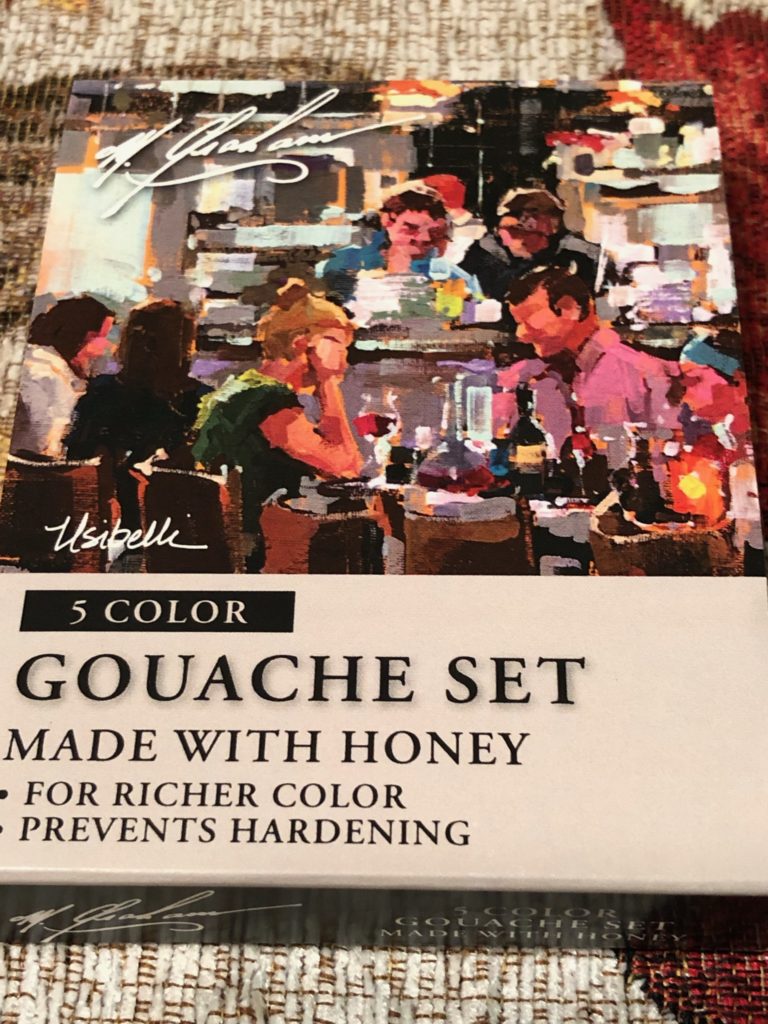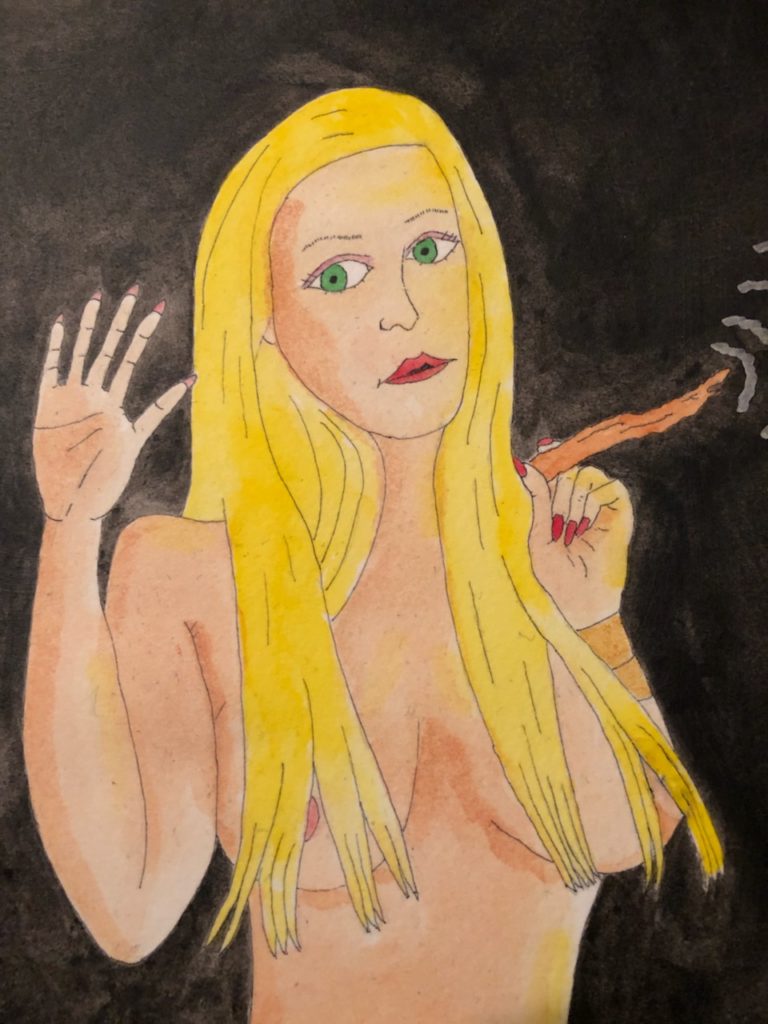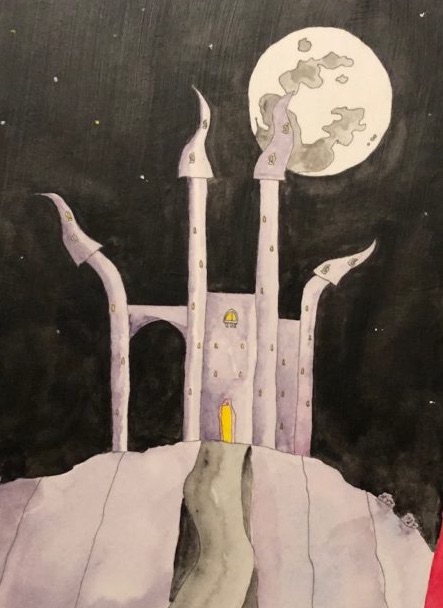I named this article “watercolor vs gouache” but in reality, watercolor and gouache are friends. They play nicely together. They even share the same paper for their main choice of surface.
But, you should know when to use one and when to use the other. Each has her own advantages and disadvantages.
So since this is a sequel to that previous article, assuming you’ve read it, I finally bought the good stuff. I’ve always been using mostly Daniel Smith watercolors with a little bit of Windsor and Newton thrown in there. But for gouache, since I’ve barely used it other than that glitter in Allie’s or Roxy’s eyes, I’ve used the cheap ass stuff. No longer.
I’ve read tons of online reviews and decided on this one:

If I’m going to compare watercolor vs gouache, I should at least compare top quality paints. So for comparisons, I’m using Daniel Smith and Winsor and Newton for watercolors. And M Graham Artists’ Gouache for gouache.
Strengths of watercolor
Layers, layers, and more layers
I paint pinups. I work with two live models – Allie and Roxy. Allie is the blonde. Roxy is the brunette.
They’re both drop dead gorgeous in real life and I love painting them both. I first start off with sketches. Then I paint.
Stylistically, I love painting women with watercolor since I could do layers after layers. After over a hundred paintings to my name (most you’ll never see), I got really good at layering.
Watercolors are fantastic for layering. Since watercolors are transparent, you can still see the bottom layers. That’s why you specifically have to paint light to dark. If you don’t, the dark will drown out the light.
When I paint my models, I use seven layers of paint, wet on wet. When complete, my pinups look fantastic. The more you paint with watercolors, the better you get with layering and colors. You’ll fall in love with your ability to layer. I can guarantee that the more you paint with watercolors.
Clean up
I have a confession to make to you. I live in a tiny ass apartment with my wife. I’d be lying if I said that wasn’t a consideration when I decided on watercolors over acrylics and oils.
Let’s actually get straight to the point. That was my main consideration.
Our apartment is so tiny that we don’t have room for anything. If my models weren’t friends of mine, they’d probably tell me where I could put my paint brushes. I literally paint on the floor. I don’t even own an easel. They barely have room to pose.
Watercolors are the easiest paints of all to clean up. They also wash right off your brushes. If you get decent brushes, they’ll last for years. You don’t have to buy brush cleaner. You just clean them off with water.
Easy to reuse
OK, time for another confession. When I mix skin colors, I use the same mix for at least three or four paintings.
The paint dries after I finish a painting. And when I start on the next painting, I simply re-wet the paint and it’s exactly the same color as before. So if I’m painting Allie three or four times in a row, which I often do, I can make a batch of the same skin color for all those paintings.
No solvents
Geez I’m getting personal here. I’m very odor sensitive. If someone stinks or is wearing too much cologne or perfume, I’ll know it before anyone else knows it. I can’t see worth shit but my nose is stronger than most people I know.
I hate the smell of solvents. I hate that smell almost as much as I hate burnt automatic transmission fluid. It’s one of my least favorite smells on the planet.
Watercolors don’t ever need solvents. You don’t need solvents for spills. You don’t need solvents for your brushes. So you don’t need to air out your home when you’re painting and/or cleaning up.
Strengths of gouache
Gouache on the other hand is opaque. I’ve heard it compared to acrylics. Some folks even refer to gouache as “opaque watercolor” for after all, it’s technically more a subset of watercolor than its own thing.
Gouache has its own character
I only have one painting to my name that is mostly gouache. And you know what? I already love gouache!
It doesn’t layer as well as watercolor. But, it’s great for covering up. If you’re going to combine gouache and watercolor, it’s probably best to paint the gouache first.
Gouache reacts differently to water than watercolor does. It gets funky with too much water. You’re going to be using less water and more paint.
Gouache also pops. You’ll know what I mean when you use it.
Cheap
I’m not a cheap person when it comes to my art. My car is a piece of shit and I don’t care. I never even repaired the dents. But for certain things, like food, tipping my bartenders and servers, and my art, I’m spending the money.
That said, it’s pretty nice when even the high end stuff is cheap. Gouache retails cheaper than watercolors. If money is a consideration, you might want to consider starting with gouache. I’m talking artist grade vs artist grade, not the good stuff for one vs the cheap stuff for the other.
Speed
Before cartoons went digital, artists used either gouache or acrylic paints for the cels. Plus, a lot of commercial artists used gouache.
Why? It’s fast. You have timelines. When under the gun, you want something fast. Gouache is perfect in those regards.
Easier to get started with
No, not the same concept as speed. I’m talking about for the very beginner.
With watercolors, I’ve said your first ten paintings will end up in the garbage. Half that with gouache. Gouache simply has easier concepts. I picked it up right away. Watercolors took awhile to pick up.
I’m not implying gouache has no technique by any means. However, if you want to at least get started with the basics, you’ll pick them up faster with gouache than you will with watercolor.
Weaknesses of watercolor
Transparency – strength that is also a weakness
Whereas I listed transparency as a strength, it’s also a weakness. For instance, if you make a mistake, you can’t just cover it up like you can do with other mediums.
Some folks use pencil as a guide. I actually ink. I actually love the look of watercolor over ink. If I do a bad job at inking, I can’t cover it up with watercolor. In that particular case, I either have to use gouache or watercolor ground to cover up the mistake.
Also, to get dark, you have to really pile on the paint. For instance, I painted four layers of wet on wet black to get this black to look like this.

Other people’s stereotypes
“Who cares what other people think?”
I do when I’m trying to sell my work. Some folks have a negative connotation to watercolors. They see it as a lesser medium to oils.
I completely disagree with them. But let’s not pretend it’s not there.
A lot of great art from the Romantic era was actually done with watercolors. The artists painted in the field with watercolors since it’s easy to transport.
Now, I could say “easy to transport” as a strength but I’ve never painted outside and I don’t ever want to give someone advice that I have never done. That would be like me telling you how to ski on an advanced slope. I’ve never done it.
I’d be either lying or regurgitating what other people have said. I don’t do that. If I’m giving you advice, it’s from my own personal experience.
But back to other people’s stereotypes, I’m hoping to help my fellow watercolor artists here. You can do more with watercolors than most people realize. I think once people see my pinups, they’ll realize how diversified and powerful watercolors really are.
Muddiness
You can avoid muddiness with experience. However, if you don’t have enough experience, you can really turn a painting muddy with watercolors. There are no easy ways to fix muddiness. It looks really bad.
Unfortunately, I’m not sure how else to explain it. It’s one of those “you’ll know it when you see it.”
Concepts take a long time to master
I feel like watercolor has some concepts that really take a long time to master. For instance, the whole concept of how water changes the colors. It’s an easy concept to understand. However, it’s a complicated concept to execute.
I got good at it with a lot of practice. For instance, look at the witch above. That paint for the inside of her nails is actually the same color for the outside of her nails and her lips. Yet, it appears like I’m using three different colors.
The difference? The amounts of water. This is something that you really have to practice a lot to execute properly.
That’s why I suggest buying a watercolor journal. Be sure to use it often and take lots of notes. I swear I have just as many words in the journal as I do actual painting examples. And I need every single word in there.
You’re going to do a lot of experimenting. Washes take a long time to master. Controlling the water takes a long time to master. And that’s just the tip of the iceberg. Advanced watercolor artists are more than likely thinking to themselves that I left out a dozen other concepts.
Weaknesses of gouache
Colors are straightforward
When you’re used to watercolors, gouache can be too straightforward. What you paint is what you get. It’s not something you’re going to layer. Blends don’t have as much depth as blends do with watercolors.
I’ll put this more in computer terms. Think about how you can take two colors with watercolor and when you blend them, you actually get eight colors if you look very closely. Now, I’m making that number eight up. But it’s for effect.
Whereas, you do exactly the same thing with gouache and you get three. Once again, I’m making that number up for effect.
What I’m getting at is you’ll get more colors when blending with watercolors than you will with gouache. Colors are more straightforward.
Now don’t get me wrong. You can still create tons of colors with gouache. But the actual numbers you’ll create when you blend will be less than you’ll get when you do exactly the same techniques with watercolors.
Nobody knows what you’re talking about
A friend of mine is a digital artist. He and his friend are working on a game as we speak. My friend is doing the artwork. I’ve seen some of his work and it’s actually pretty good.
When I told him that I just bought a gouache set, he said “what the fuck is gouache?”
Commercial art stereotype
And of those who do know what you’re talking about when you mention gouache, many of them only think of commercial art. Which, I think there’s nothing wrong with.
I may get chastised for this, but I don’t romanticize the starving artist. Sometimes artists have families. And families need to eat.
If you take a job making art for a corporation so you can actually eat, I get it. I’m not one of those people who plays holier than thou and think artists have to follow some strict moral code or take a vow of poverty.
But those people are out there. They think everything commercial is bad, and the only way to make it as an artist should be to sell your own work privately, and not working for The Man.
Whatever. I’m not one of those people.
Those people also thumb their noses at gouache for this very reason. Gouache at one time was the most common medium for print ads. If I’m not mistaken, digital art surpassed gouache long ago.
So they see it as a less than serious medium. Which is a shame since there is some really cool gouache work out there. I happen to love Olivia De Berardinis for instance, who makes some pretty dang fine pinups with gouache.
Gouache is harder to get off brushes
I have two Kim-chi jars when I paint with watercolors. One I use to wash the brush. The second I use for the final rinse.
With gouache, I still use the same method. However, it takes a lot more swishing to get all the gouache paint off the brushes than it does with watercolor.
Is this a big deal? Not really. You’re just going to have to work harder at keeping the brushes clean. But it’s definitely noticeable.
Note – this may not necessarily be a gouache thing and might be an M Graham thing. M Graham is honey based, and if that’s the reason why it’s harder to get off the brushes, it’s the brand, not the type of paint.
Can you mix them?
I did. The sky you see here is actually M Graham gouache combined with Daniel Smith watercolor. I like how it turned out.
Watercolor vs Gouache – Final verdict
You already know what I’m going to say about the whole watercolor vs gouache debate. I’ve said it before and I’ll say it again. I use both.
I finally bought some good quality gouache as pictured up above and I love it. You can see what I use watercolor for and what I use gouache for. When I want to layer something heavily, I’m using watercolors. When I want opaque, I use gouache. So it totally depends on what I’m working on.


Thank you so much for this article! I am trying to fix a mistake I made years ago on a watercolor. All of my relatives want a copy of this painting, but I didn’t want copies of what I see as a mistake in perspective. I’m thinking that gouache is my way out. if I cover my mistake with white gouache, maybe I can repaint the faulty area with watercolors over the gouache?
Thanks for the comment Barbara.
You can try and hopefully that will work. You can also try to use watercolor ground, although the ground will elevate it a bit.
I’d strongly suggest trying both your idea (gouache, then watercolors) and the watercolor ground on a piece of scratch watercolor paper first to see which one you’re more comfortable with.